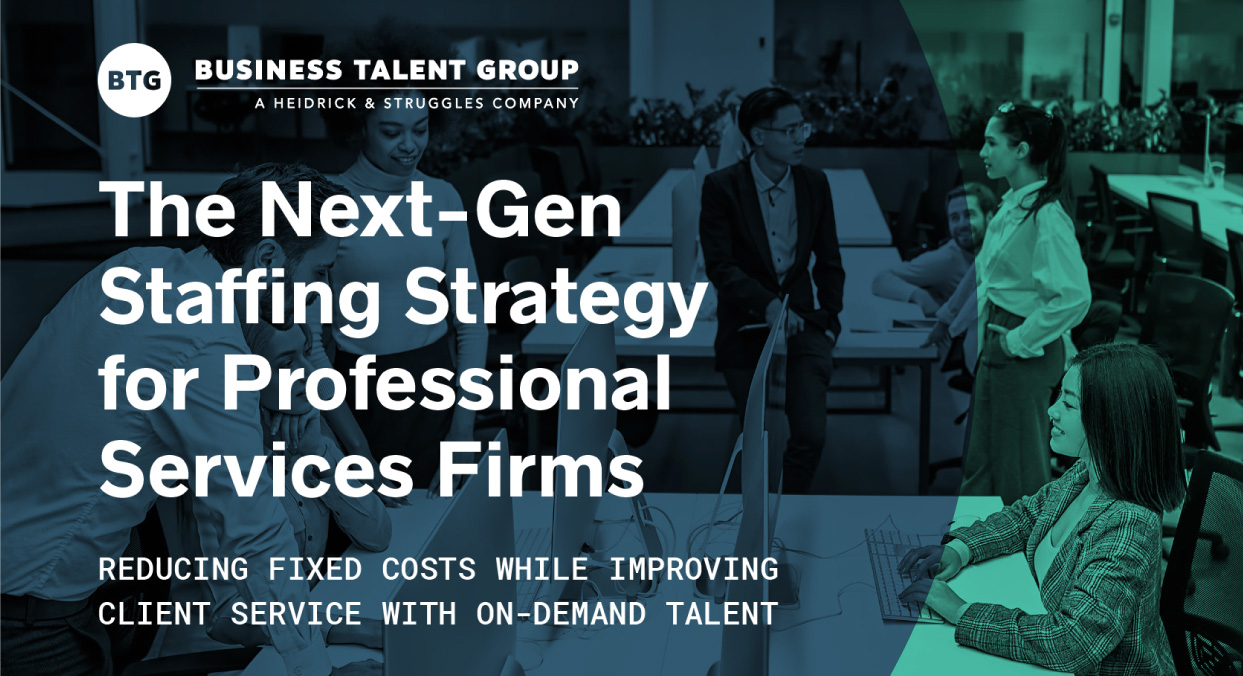
Amid today’s economic uncertainty, cost-cutting mandates have become an unpleasant daily reality for many business leaders. Balancing belt-tightening with improving profitability and resilience is no easy task, and it’s even more challenging when teams lack the bandwidth and expertise they need to pursue innovative transformations.
At times painful and other times groundbreaking (and frequently both), the lessons learned from the ups and downs of the pandemic economy are informing strategic plans for the future. Creative business leaders are figuring out how to cut costs while innovating, and on-demand talent offers a similar solution when it comes to tackling big initiatives with slim teams.
Shrinking in Order to Grow
In rethinking their near- and long-term cost structures, many companies are choosing to reduce costs by reducing their headcounts. Others are reevaluating and refining their strategic priorities to determine which projects can be pared back or eliminated, as well as which are likely to realize the greatest returns. In both cases, it’s all about downsizing.
Each of these approaches affects the other, however. Downsizing might be the quickest way to shrink costs, but without careful consideration of the skills and experience needed to fulfill future goals, it can be a double-edged sword. At the same time, Covid has caused such a fundamental shift in business goals, that many organizations might already be lacking the expertise they need to recover and/or thrive in the “new normal.”
This has given rise to a “build, buy, borrow” talent strategy for cost reduction. In the past, companies that downsized were averse to engaging on-demand talent, since it seemed like a net-zero approach. What business leaders are realizing now, however, is that nimble, focused talent strategies yield the greatest advantage—in terms of both cost-reduction and growth.
Securing the Necessary Expertise
Early on in Covid, it became clear that flexibility would be what divided the businesses that thrived from those that struggled to survive. The ability to pivot became paramount, and uncertainty gave rise to innovation. Though some companies possessed the in-house resources to quickly adjust—most did not. Employees who weren’t furloughed found themselves stretched thin, as did execs who were suddenly juggling multiple full plates.
As a result, on-demand talent became critical. Whether acting as C-suite strategists, analysts, or project managers, high-end freelancers provided the flexibility and experience needed to right ships and keep them from running ashore. Now that the tide is finally turning, companies are drawing on their expertise for direct and indirect assistance with cost-reduction efforts.
Indirectly, on-demand experts offer a cost-effective alternative to bringing in a big, traditional consulting firm. As operations ramp back up, they can also be a compelling alternative to hiring new full-time employees. Their direct impact is where they offer the most value, though. With CVs packed with officer titles, operational expertise, and consulting experience, they’re able to jump right into projects to accelerate the identification and execution of specific cost-savings opportunities. Here’s how:
Identifying opportunities
The value of innovation isn’t limited to what a business can gain; it can also be used to trim excess and improve efficiency. As BTG talent and former Bain consultant Steven Wunker writes, “Using innovation to cut costs…can improve the customer experience while simultaneously lowering expenses.” He recently spoke with BTG's Sandra Pinnavaia about his Costovation framework.
Being innovative requires a thorough understanding of your specific customer base. Knowing what your target market wants is just as important as identifying what it doesn’t need. A well-focused product builds loyalty by demonstrating this understanding. Plus, eliminating features tends to be less resource-intensive than adding more bells and whistles.
Applying that same sense of focus to your processes can also reveal cost-savings opportunities. When a multinational beverage company wanted to shutter a failing plant, BTG connected its project management office with a manufacturing operations expert who had trained at Deloitte. While developing a plan for moving production to a lower-cost facility, the expert identified a number of operational inefficiencies that had been causing the plant to struggle. With the innovation spurred by that insight, the company discovered the issues could be resolved to realize a higher long-term return than if the plant were shut down.
Outside perspectives can be powerful catalysts for innovation. When brought in as freelance support, they can also lighten the load and help cultivate a more focused process. The result is, inevitably, greater operational agility and cost efficiency.
“Frequently, the reason companies need an interim officer or a consultant is because they are trying to do too many things at once,” says Carl Lane, Chicago-based business transformation and turnaround management specialist. “They lack focus. So, I help management identify which changes will make the most impact, take their to-do list from 50 down to five, and then help them make those changes quickly.”
Developing a roadmap for realizing cost savings
Once potential opportunities are identified, the path forward must be equally well defined. Knowing your audience helps shape your value proposition; ranking the resulting strategic priorities helps drive it.
Wunker recommends surveying the landscape and casting a wide creative net—zigging where others zag—and making sure not to mistake longstanding trends for critical templates:
“Draw inspiration from what companies are doing in other geographies, understand how companies might be tackling the opportunity by coming at it from totally different directions, and push your creativity through mechanisms like workshops to generate an expansive yet tractable number of ways to address the needs you’ve identified.”
This can be a distinct challenge for companies with an entrenched resistance to change or a habit of hiding behind “tried-and-true” methods. It can also be daunting for organizations that simply lack the resources to perform adequate competitive research or organize strategy workshops. Bridging these gaps to help create a detailed, action-driven roadmap is something on-demand experts do every day.
Case in point: When the VP of Sales at a multi-billion dollar data giant knew the company’s sales process was suffering from workflow inefficiencies, he asked BTG to connect him with an expert who could help fix it. We sent in a lean service operations expert and a business performance improvement specialist to identify process improvements and roll out the changes at an offsite workshop. The resulting productivity enhancements helped the company reduce related costs by 30%.
Executing the roadmap
This is the point at which traditional consulting firms often disengage: The roadmap is in place, and now it’s on the company to execute. But even the best-laid plans will fail without adequate leadership, management, and guidance.
Fortunately, this is another area where high-end freelancers shine. Not only are they cost-effective alternatives to traditional consulting firms in and of themselves, they’re also highly skilled and execution-oriented. They know how to apply the roadmap, and they’re hands-on in doing it. Many possess both operational and consulting expertise, which means they’ll keep an eye out for additional cost-savings opportunities, too.
The Head of Transformation for an F500 financial services company once approached BTG because he was struggling to address inefficiencies that had been identified by a Big Three consulting firm. The firm had outlined improvements, but the company was having trouble mapping them to its operations. Our team, led by a former Big Three consultant and lean process expert, examined the firm’s recommendations, analyzed everything, and designed a detailed execution process that could achieve the client’s goal of improving profitability by 20%.
Final Thoughts on Cost Reduction as a Means of Growth
Though downsizing often means reducing headcount, it’s still essential to make sure you have the right people in place. Do your existing resources have both the bandwidth and the expertise to lead the transformative projects that will have the greatest impact on your bottom line? Cost-saving initiatives including operational improvement, turnaround and recovery, sales or finance restructuring, and change management can all benefit from bringing in high-end freelance talent to strategize and/or guide the project to success.
Whether you’re looking for innovative ways to cut costs at your organization, or you could just use some help getting across the finish line, our on-demand experts are here to help. Tell us about your project >
Get the Skills You Need
Thousands of independent consultants, subject matter experts, project managers, and interim executives are ready to help address your biggest business opportunities.
About the Author
More Content by Emily Slayton






















